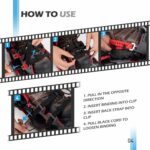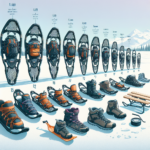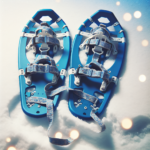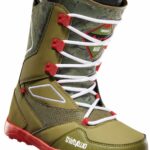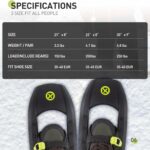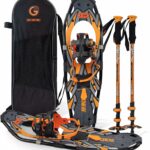You’ve finally decided to conquer the snow-covered mountains with your snowboard. But perplexed about the optimal size of your snowboard? Fear not! Picking the perfect snowboard isn’t about grabbing the coolest or most expensive one; it’s about understanding your specific needs. This article is an insightful guide on “How Tall Should Your Snowboard Be On You?”, aiming to shed light on the essential considerations of proportionality and balance and their impacts on your snowboarding experience.
Understanding the Basics of Snowboard Sizing
Snowboarding is an exhilarating winter sport that many people enjoy. To maximize your enjoyment on the slopes, it’s essential that your gear is set up correctly. First and foremost, you should understand the importance of getting the right snowboard size.
The importance of correct snowboard size
Choosing the correct size of your snowboard is critical. The right size influences how well you can control the board and the overall ease and comfort of your ride. It can also alter your speed and ability to perform tricks. Riding on a snowboard that’s the wrong size can even increase your risk of injuries.
Factors affecting snowboard size
Several factors influence what size of snowboard is right for you. These include your height and weight, your snowboarding style, your experience level, and even your gender. When it comes to kids, their growth also plays a significant role.
Height as a Primary Factor in Snowboard Sizing
Why height matters in snowboard sizing
Your height is a central factor when determining the right snowboard size. This is due to how much control you can have over the board. A snowboard that’s too short or too tall for your height can make your movements clumsy and inadequate, leading to a frustrating day on the slopes.
General rule of thumb according to height
A snowboard should generally reach anywhere from your chin to your nose when stood up on its end. If you’re more of a casual rider, go for the shorter end of this range. For those more intrepid in their snowboarding adventures, opt for the longer end of this scale.
Exceptions to height-based sizing advice
There are exceptions to these rules. For instance, if you plan to perform tricks and jumps, you may want a shorter board for more maneuverability. Alternatively, if you primarily want speed and stability on steep slopes, you might prefer a longer board.
Weight as a Considerable Factor
The role of the snowboarder’s weight
Another factor to factor in snowboard sizing is your weight. Snowboards, like skis, creates a pressure distribution across the snow, and if you’re too heavy for your board, it will submerge more than it should. On the flip side, if you are too light, you won’t be able to control it properly.
How weight impacts snowboard performance
Your weight affects how the snowboard flexes and how much edge engages the snow. Too much weight will cause the board to flex more than intended, making it feel loose, unstable, and harder to control. Conversely, a lack of weight can result in an uncomfortable, rigid ride.
How to factor in weight when choosing a snowboard size
Most snowboards come with a weight range suggestion based on board length. Use this range as a general guide, but remember, your height and style of snowboarding may require some adjustments.
Your Snowboarding Style and Snowboard Length
Different snowboarding styles and corresponding snowboard lengths
You should consider the style of snowboarding you prefer when choosing your board’s length. Freestyle and freeriding, for example, require different board lengths for optimal performance.
Adjusting snowboard size for freestyle
Freestyle snowboarding often involves tricks and jumps in the terrain park. Opt for a shorter than average snowboard for this style, as it allows more maneuverability and makes the board easier to spin and flip.
Adjusting snowboard size for freeriding
Freeriding focuses on ungroomed runs, steep slopes, and backcountry or off-piste boarding. Choose a longer snowboard for this, as it offers better stability at high speeds and better flotation on deeper snow.
Experience Level and Snowboard Length
Ideal snowboard lengths for beginners
If you’re just starting out or identify as a beginner in the world of snowboarding, shorter boards are often easier to handle. They allow you to learn how to turn and control speed without excess length getting in your way.
How experience uses different snowboard sizes
As you gain experience and confidence on the slopes, you might want to experiment with longer boards. These can provide more stability and speed, especially on steeper slopes.
Transitioning to longer boards as skills improve
When you’re ready to hit the slopes with more intensity, transitioning to a longer board might be beneficial. Ensure that this transition is gradual and aligns with your ability level to avoid unnecessary frustration or potential injuries.
Gender and Snowboard Sizing
Differences in body proportions between genders
Gender plays a role in snowboard sizing due to the typical differences in physical characteristics between men and women. Notably, men are often taller and heavier than women, which can influence the right choice of snowboard size.
How average height and weight of genders impact snowboard size
Because men tend to be taller and heavier, they generally require longer and stiffer snowboards than women. Women-centered boards are typically shorter, narrower, and more flexible to accommodate for average height and weight differences.
Snowboard size for women Vs men
As a general rule, women’s snowboards are designed to match women’s average height and weight. Accordingly, they are typically shorter and lighter than men’s boards. Simultaneously, men’s snowboards are designed to be taller and more robust to support larger body frames.
Kids and Snowboarding: Sizing Tips
Snowboard length for children
When sizing a snowboard for a child, the general rule is to choose a board that reaches somewhere between the child’s chest and chin. This way, they can easily manage and control the board while learning.
Progression of snowboard sizes as children grow
As your child grows, so should their snowboard. Gradually move them up in board sizes to ensure they continue to have control, comfort, and most importantly, fun on the slopes.
Additional factors to consider for kids
Bear in mind that the proper length also depends on a child’s skill level and the type of riding they’re doing. Weight is another crucial factor to consider, as lightweight kids might have difficulty maneuvering boards designed for heavier riders.
The Impact of Boot Size on Snowboard Width
Correlation between boot size and snowboard width
Snowboard width is primarily determined by boot size. Opting for a board that fits your boot ensures that you have enough leverage when turning and avoids overhang that could create drag.
Ensuring proper boot overhang for optimal performance
It’s crucial to ensure that your boots just slightly overhang the edges of the snowboard for maximum performance. Too much overhang can result in your toes or heels dragging in the snow during turns, leading to loss of control.
How to avoid toe and heel drag
Toe and heel drag can greatly disrupt your snowboarding experience. When choosing a snowboard width, make sure your boots overhang your snowboard by no more than 1-2cm on each side to avoid this issue.
Type of Snow, Terrain, and Conditions
How snow conditions affect snowboard length
The type of snow you ride on can greatly impact the optimal length of your board. Softer and deeper snow generally calls for a longer board for more surface area and better float. On harder snow, a shorter board is generally easier to control and maneuver.
Choosing snowboard size for different terrains
Steep, ungroomed terrain usually warrants a longer and stiffer board for increased stability, while less serious terrain or park riding often calls for a shorter and more flexible board for enhanced maneuverability.
Adjusting snowboard size for deep snow and groomed runs
When you’re venturing out into deep snow or backcountry, you’ll want to look at longer boards. They provide better float and handle powder better than shorter options. On the other hand, groomed runs can be easily tackled with a shorter board, as they allow for sharper turns and more control.
Experimenting With Different Snowboard Lengths
The benefits of trying different snowboard lengths
Experimenting with various snowboard lengths can be a great way to discover what works best for you. Different lengths offer different benefits and drawbacks, and trying out a variety can help you figure out what suits your riding style the most.
Getting comfortable on various snowboard sizes
Trying different boards and lengths can also make you a more versatile rider. You’ll become comfortable in different conditions and terrains, and you’ll gain a better understanding of how snowboard size affects your performance.
How different lengths affect your ride
Ultimately, the length of your snowboard affects how it behaves under your feet. A longer board might feel stable and powerful, but less agile. Conversely, a short one can feel playful and maneuverable, but not as stable at high speeds. Understanding this can help you choose the right board for your style and terrain.
Remember, when it comes to snowboard sizing, there’s no one-size-fits-all formula. It’s a blend of several factors like your physical characteristics, experience level, and the type of snowboarding you plan to do. By considering all these factors, you can assure yourself a safe and enjoyable experience on the slopes.
- What Snowboard Bindings Should I Get? - January 23, 2024
- What Size Screws For Snowboard Bindings? - January 23, 2024
- How To Snowmobile On Water? - January 23, 2024


